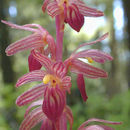en
names in breadcrumbs


Corallorhiza striata is a species of orchid known by the common names striped coralroot and hooded coralroot. This flowering plant is widespread across much of southern Canada, the northern and western United States, and Mexico.[1][2][3] It lives in dry, decaying plant matter on the ground in pine and mixed coniferous forests, and it obtains its nutrients from fungi via mycoheterotrophy.

Like other coralroot orchids, the plant takes its name from its coral-shaped rhizomes.[4] It has an erect stem about 15 to 50 cm (6 to 20 in) tall that may be red, pink, purple, or yellow-green to almost white. The leaves lack chlorophyll and are reduced to colourless scales that sheath the stem. The plant also lacks roots, and relies upon parasitism of fungi for sustenance.
The stem is topped by a raceme of 15 to 25 orchid flowers. Each flower is an open array of sepals and similar-looking petals that may be pink or yellowish and have darker pink or maroon stripes. Inside the flower is a column formed from the fusion of male and female parts, which may be spotted with purple or red. The fruit is a capsule one or two centimeters long.[5]
Corallorhiza striata is a species of orchid known by the common names striped coralroot and hooded coralroot. This flowering plant is widespread across much of southern Canada, the northern and western United States, and Mexico. It lives in dry, decaying plant matter on the ground in pine and mixed coniferous forests, and it obtains its nutrients from fungi via mycoheterotrophy.